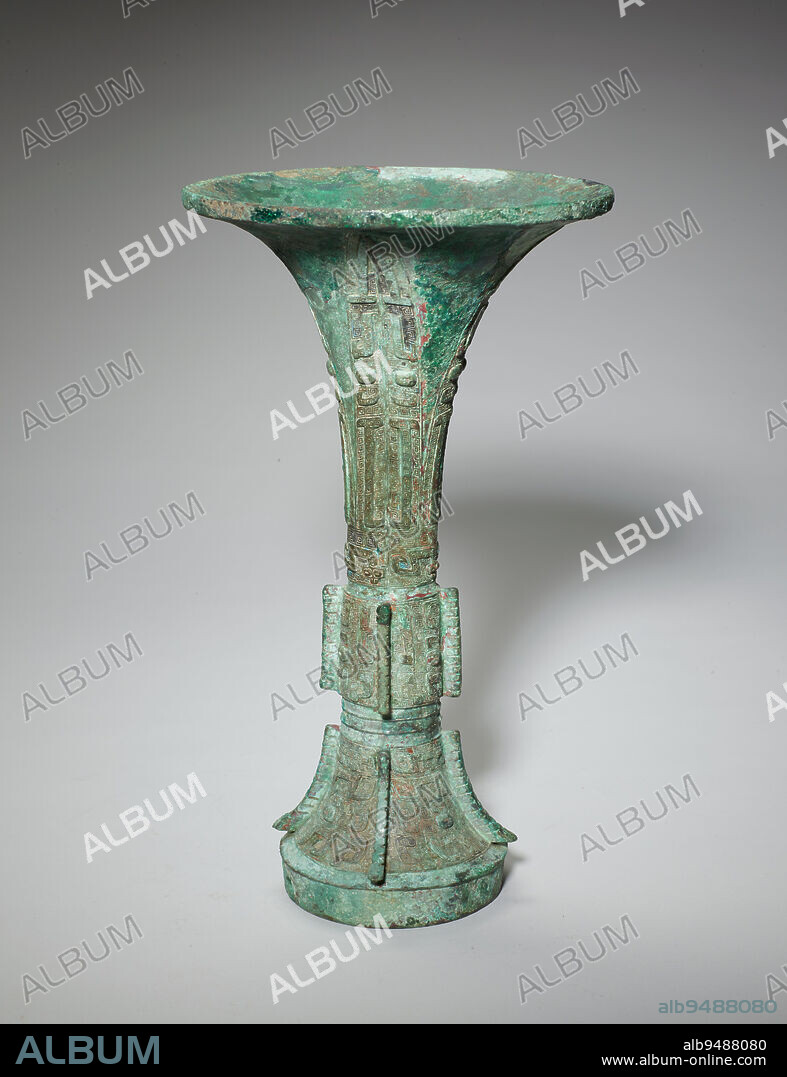alb9488080
Gu wine vessel, 12th-11th century BCE, 11 3/4 × 6 5/8 in., 3.3 lb. (29.85 × 16.83 cm, 1.5 kg), Bronze, China, 12th-11th century BCE, The gu is a tall wine beaker with an unusually taut and graceful silhouetteits trumpet-shaped top tapers to a slim center section before widening again to a slightly flared base. Archaeological evidence reveals that bronze gu first appeared during the Erligang period (c. 15001300 BCE) of the Shang dynasty. The gu enjoyed its greatest popularity during the Shang dynasty (c. 16001046 BCE), but became less popular in the early Western Zhou (c. 1046977 BCE), before gradually disappearing during the Eastern Zhou dynasty (770256 BCE). The gradual decline of the wine vessel may have something to do with the Zhou kings deprecation of alcohol consumptionhe believed that overindulgence in alcohol resulted in the collapse of Shang. This gu is decorated with variations of the taotie (composite animal) mask. The background pattern of tight spirals, found all over the vessel, is called leiwen and is a hallmark of Shang bronze casting.

|
Ajouter à une autre Lightbox |
|
Ajouter à une autre Lightbox |



Avez-vous déjà un compte? S'identifier
Vous n'avez pas de compte ? S'inscrire
Acheter cette image.
Sélectionnez l'usage:

Légende:
Voir la traduction automatique
Gu wine vessel, 12th-11th century BCE, 11 3/4 × 6 5/8 in., 3.3 lb. (29.85 × 16.83 cm, 1.5 kg), Bronze, China, 12th-11th century BCE, The gu is a tall wine beaker with an unusually taut and graceful silhouetteits trumpet-shaped top tapers to a slim center section before widening again to a slightly flared base. Archaeological evidence reveals that bronze gu first appeared during the Erligang period (c. 15001300 BCE) of the Shang dynasty. The gu enjoyed its greatest popularity during the Shang dynasty (c. 16001046 BCE), but became less popular in the early Western Zhou (c. 1046977 BCE), before gradually disappearing during the Eastern Zhou dynasty (770256 BCE). The gradual decline of the wine vessel may have something to do with the Zhou kings deprecation of alcohol consumptionhe believed that overindulgence in alcohol resulted in the collapse of Shang. This gu is decorated with variations of the taotie (composite animal) mask. The background pattern of tight spirals, found all over the vessel, is called leiwen and is a hallmark of Shang bronze casting.
Crédit:
Album / quintlox
Autorisations:
Modèle: Non - Propriété: Non
Questions sur les droits?
Questions sur les droits?
Taille de l'image:
4982 x 6483 px | 92.4 MB
Taille d'impression:
42.2 x 54.9 cm | 16.6 x 21.6 in (300 dpi)
Mots clés:
BRONZE • BRONZES • CHINE • DYNASTIE DES ZHOU DE L'EST • DYNASTIE SHANG • ÉBOULEMENT • ECROULEMENT • MASQUE • MASQUÉE • MATERIAU BRONZE
 Pinterest
Pinterest Twitter
Twitter Facebook
Facebook Copier le lien
Copier le lien Email
Email
